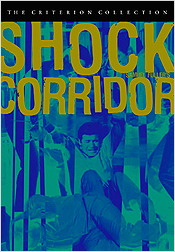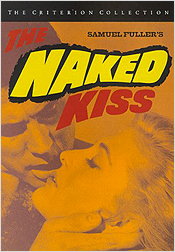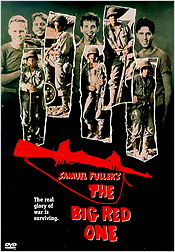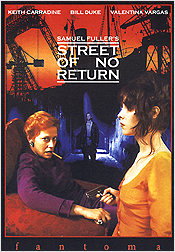 |
Site created 12/15/97.

page created: 5/6/03
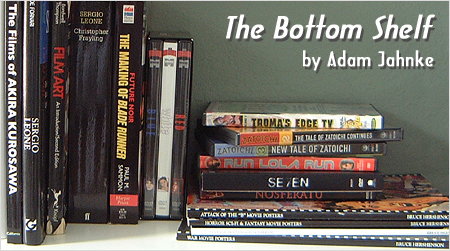 Film is a Battleground: Samuel Fuller on DVD Adam Jahnke - Main Page |
| For
hard-core movie buffs, there are two kinds of people. There are Sam
Fuller fans and there are people who don't realize they're Sam
Fuller fans yet. Beginning in 1949 with the western
I Shot Jesse James, Samuel
Fuller crafted an iconoclastic, highly stylized body of work that is
instantly recognizable as belonging to no one else. His movies are
tough, frequently violent, and without exception, totally without
glamour and the Hollywood notion of romance. Fuller shot most of his
movies independently and even those that he made from within the
studio system were on the fringes, mostly B-pictures that the
studios hadn't invested a lot of money in and therefore weren't
particularly interested in or worried about. Like a lot of unsung American filmmakers, Fuller has always enjoyed a much greater reputation in Europe than he has at home. But every few years, something will come along to give the Fuller faithful hope that perhaps the situation will start to change. Maybe someone like UCLA or the American Cinematheque in Los Angeles will program a retrospective of his work. Maybe someone will make a documentary, like 1996's terrific The Typewriter, the Rifle & the Movie Camera. Late last year, Fuller's posthumous autobiography was finally released. The book, titled A Third Face and brought to completion by Fuller's widow Christa Lang Fuller and longtime friend Jerome Henry Rudes, received rave reviews, even landing on Entertainment Weekly's list of the top ten nonfiction books of 2001. With all this attention and such high-profile fans as Quentin Tarantino, Tim Robbins, and Martin Scorsese frequently singing his praises, you'd think the time for a Samuel Fuller renaissance would be now. You'd be wrong. Fuller's American profile has always been hampered by the frustrating unavailability of most of his movies on home video. DVD's sudden surge of popularity has given new life to a wide array of cult filmmakers. Everyone from David Lynch and John Waters to Lucio Fulci and Seijun Suzuki has benefited from new interest in their most difficult to see films. But this wave has passed Sam Fuller by. As of this writing, only four (four!) of his twenty-three theatrical movies have been released on DVD. Well... four and a half if you count The Meanest Men in the West, a compilation of episodes from The Virginian released by Goodtimes, and I don't. At this point, you can actually see more of his appearances in movies by other directors on disc than you can Fuller's own films. These include Steven Spielberg's 1941, Jean-Luc Godard's Pierrot le Fou, and Wim Wenders' The American Friend and The End of Violence, which featured Fuller's very last work before his death in 1997. I'm here to tell you that this is a crime against cinema and a situation that must be changed. Before I harangue you and the powers-that-be at the various studios with my plan to save Sam Fuller, let's take a look at what is available. Fortunately, the four movies that are already out there feature some of his very best work. I believe once you take a look at these movies, you'll be hooked and will join me in demanding more Fuller on DVD. |
Before he turned to filmmaking, Sam Fuller was an East Coast crime reporter and newspaper ink ran through his veins for the rest of his life. So it's no surprise that one of his very best films centers on a journalist. An inmate at a state run mental hospital has been murdered and nobody seems terribly interested in finding out whodunit. Enter Johnny Barrett (Peter Breck), a Pulitzer-hungry reporter who goes undercover to unmask the culprit and expose the inner workings of the asylum. Trouble is that all three witnesses he has to interview are totally nuts. Stuart (James Best) believes he's still fighting the Civil War. Trent (Hari Rhodes) is a black student who spouts segregationist rhetoric and is prone to stealing pillowcases to fashion his own KKK outfit. Boden (Gene Evans) was a Manhattan Project scientist who regressed to childhood after the bomb was dropped on Hiroshima. So Barrett gets himself committed, persuading his stripper girlfriend Cathy (Constance Towers) to pose as his sister and convince the doctors that "brother" Johnny harbors incestuous feelings toward her. It isn't long before the central question surrounding the mystery, "Who killed Sloan in the kitchen?" takes a backseat to, "How long can a man hold on to his sanity when everyone around him believes him to be insane?" The closer Barrett gets to solving the mystery, the more tenuous his grasp of reality becomes. Shock Corridor is Fuller at his best, full of memorable supporting characters, tense set pieces, and stark, moody black and white cinematography provided by Stanley Cortez. Criterion deserves praise for restoring the original color sequences back into the film. These scenes were shot by Fuller himself around the world with no particular project or purpose in mind. But Fuller was far too economical a director to let perfectly good footage go to waste, so he incorporated them into Shock Corridor as manifestations of the witnesses' delirium. The hallmark of Fuller's best films is his ability to weave weighty issues into a tapestry of pure pulp fiction. Shock Corridor is a masterful example of this, by tackling three of the biggest issues facing early-60's America, racism (a favorite topic of Fuller's), war (another one), and rampant anti-Commie hysteria, and stuffing the whole ball of wax into an asylum. Fuller's next movie, The Naked Kiss, wasn't quite as ambitious as Shock Corridor but is still a top-flight melodrama. Constance Towers returns in The Naked Kiss, this time as Kelly. Kelly is given one of the most memorable introductions in movie history, beating the shit out of a guy who's cheated her. In the middle of the fight, the guy pulls off her wig, revealing her to be completely bald. Kelly knocks him out, rummages through his pockets and finds a huge wad of money. She takes just the $75 owed her, puts her wig back on, and hits the road. Cut to two years later. Kelly steps off the bus in Grantville, USA, looking to set up shop as a "champagne saleslady" (i.e., hooker). Her first... and last customer in Grantville is Griff (Anthony Eisley), a corrupt cop who tells her to head across the river and become a "bon-bon girl" at the whorehouse run by Candy (Virginia Grey). But Kelly's sick and tired of the life she's been living and instead takes a room at a local boarding house and a job as a nurse caring for crippled children. She finds love with Grant (Michael Dante), the rich young magnate whose family the town is named for. Griff doesn't trust her for a second and threatens to expose her sordid past to Grant. But Kelly's already done that and Grant has accepted her for who she is, so it seems as if things are finally going to turn around for Kelly. That's when Grant reveals a secret even uglier than anything in Kelly's past and everything goes to hell. Your first thought while watching The Naked Kiss will likely be, "I can't believe this was made in 1964." While earlier B-movies, noirs, and thrillers had danced coyly around some of the more unpleasant details of their characters, The Naked Kiss grabs the audience by the scruff of the neck and makes us look it right in the face. This is also one of the most interesting female characters to come out of the genre. Kelly is hard as nails when necessary but totally devoted to the young children under her care and protective of her fellow nurses when she sees them beginning to go down the same path she's already traveled. With its startlingly matter-of-fact treatment of violence and sexual perversion, mixed with some of the most insipid homespun platitudes you'll see, The Naked Kiss is one strange movie. If David Lynch had made Blue Velvet or Mulholland Drive back in 1964, it might have looked something like this. Both The Naked Kiss and Shock Corridor were two of Criterion's earliest DVD releases (their spine numbers are 18 and 19, respectively), so I have to cut them some slack if they don't look or sound as good as their more recent work. The prints for both movies are in reasonable, if not exceptional, shape. Each of them exhibits some dirt, scratches and other flaws here and there. As for their digital transfer... well, they ain't great. Shock Corridor in particular suffers from some extremely noticeable edge enhancement that makes some of the characters glow as if they're radioactive. Neither disc is enhanced for 16x9 monitors. Audio in each case is the original monaural track and both are serviceable. I imagine if Criterion decided to reissue these discs today, most of the video problems would be corrected but the sonic purists at Criterion wouldn't allow the audio to get much better than this. Extras on both disc are limited to the films' original trailer and the usual appreciative liner notes found on most Criterion releases. Shock Corridor's are contributed by River's Edge director Tim Hunter, while The Naked Kiss is by film writer Michael Dare. |
The Naked Kiss was something of a commercial disappointment and Sam Fuller spent the rest of the 1960's and most of the 70's scrambling to get funding for another film. His comeback finally came with 1980's The Big Red One, a return to war movies (he'd previously tackled the genre in The Steel Helmet, Fixed Bayonets, and Merrill's Marauders). Fuller had been drafted and served in the First Infantry during World War II. The Big Red One is the most blatantly autobiographical of his films, based in large part on his experiences during the war. Lee Marvin stars as the sergeant in command of the division known as the Big Red One, so called because of the insignia worn on their shoulders. Men come and go but four are luckier than most, surviving skirmishes from North Africa to Belgium. These four (played by Mark Hamill, Bobby DiCicco, Kelly Ward and Robert Carradine as Zab, Fuller's stand-in) come to be known as the Sergeant's Four Horsemen. There's no real plot to The Big Red One. The film simply follows these four men through the war, storming Omaha Beach, raiding a Belgian asylum being used as a Nazi base of operations, and ultimately liberating a concentration camp in Czechoslovakia. Any lingering doubt that Sam Fuller was a director ahead of his time should be dispelled after watching The Big Red One. The movie feels authentic, not because of flashy camerawork or graphic violence but simply because Fuller was actually there and fills the characters and situations with a realism that someone who's merely interviewed veterans can never grasp. This is no band of brothers we're following. The four main characters develop a bond based on their shared survival and tacit understanding that the only reason they've lasted this long is that they got lucky. The other men in the division are just "replacements" and Carradine admits that after a point, they stopped even trying to get to know them. They knew they'd soon be dead anyway. More often than not, they can't even remember the names of the babyfaces who have joined their group. One can only imagine what Fuller would have made of, and even more tantalizingly, what he would have done with, something like Saving Private Ryan. Warner Bros. has essentially dumped The Big Red One onto disc with little to no effort. At the very least, they have included a letterboxed version of the movie along with the pan and scan version on side two. But this is about all that saves this DVD from being a total disaster. The picture is adequate. Although it's enhanced for widescreen monitors, the studio obviously made no moves to clean or restore the print. The sound is simply atrocious. I had to watch this movie with my thumb on the volume control the entire time. Dialogue, especially that delivered by Lee Marvin's rich bass voice, often becomes totally unintelligible unless you crank the volume up. After which, you'll be blown out of the back of the room by explosions and gunfire. Extras are nonexistent, not even a trailer. The Big Red One is a great movie and deserves a much better release than this. |
For a disc with any sort of substantial extras about Sam Fuller, you have to seek out one of his most obscure titles. Cult label Fantoma has recently released Street of No Return, Fuller's last theatrical release. Fortunately, this is a disc well worth the search. Street of No Return opens with a bang, literally. The very first shot is of a guy taking a hammer blow straight to the head. We're in the middle of a race riot that's erupted on the streets of an unnamed American city. Watching from the sidelines is Michael (Keith Carradine, Robert's brother). Years ago, Michael was living the high life as a rock star. That is, until he fell for Celia (Valentina Vargas), the gorgeous girlfriend of criminal mastermind Eddie (Marc De Jong). In retribution for stealing his girl, Eddie slashes Michael's throat, destroying his vocal chords and robbing him of his one gift. Now, Michael lives on the streets, all wild eyes and wilder hair, drinking the booze left in the shards of broken whiskey bottles and able to speak only in a croaked whisper. In the aftermath of the opening riot, Michael discovers that Eddie's behind the racial tensions tearing the city apart. He teams up with the beleaguered police chief Borel (Bill Duke) to bring Eddie down and rescue Celia. Street of No Return isn't a great movie but it's certainly enjoyable and instantly recognizable as belonging to Sam Fuller. From the stylized dialogue to the moody cinematography of French DP Pierre-William Glenn, the movie snaps along with Fuller's usual intensity. While the story occasionally becomes unfocused, it never threatens to derail entirely and, at a brisk 92 minutes, never outlives its welcome. Street of No Return also has that weird limbo feel of a movie set in America but obviously shot on location in Europe (in this case, Portugal). This actually helps in this case, since this is a city populated by people with just one name (Michael, Celia, Borel) who seem to be totally adrift and unable to control their own lives. Fantoma deserves congratulations for rescuing Street of No Return from obscurity and even more praise for bringing it to DVD in style. The anamorphically enhanced picture is very nice, exhibiting only mild shimmering here and there to distract the eye. Apart from that, the disc makes it easy to get lost in Glenn's smoke and shadow filled cinematography. The 5.1 surround audio is surprisingly aggressive, filling the rear speakers with gunfire, action and music. Dialogue is front and center and it's easy to tell which characters were dubbed in post-production but there isn't much to be done about that. Finally, Fantoma has released a disc with extras worthy of Fuller's body of work. The highlight is a 30+ minute documentary, The Making of Street of No Return, shot on location by an apparently French film crew. The piece is full of valuable footage of Fuller at work, chomping on his ubiquitous cigars and regaling the crew with war stories. This feature demonstrates what a tragedy it is that Fuller died before DVD became a force to be reckoned with. He was one of the most memorable characters to ever helm a film. Unlike a lot of directors, who'll fill a making-of piece with fluff like what movies inspired them, Sam Fuller was a born storyteller who actually lived a life outside of Hollywood. He answers every question with an anecdote from his days on the crime beat or the war or his early days as a writer. If Fuller had lived, he would probably have to record two or three commentaries for each of his films, just to get all the stories in. Keith Carradine provides an audio commentary over the film itself in which he provides his observations and remembrances of Fuller... and struggles to remember anything specific about the making of the film itself. He has less and less to say as the movie goes on but the commentary is still worth at least half a listen. His memories of Fuller are warm and respectful and he's refreshingly candid about the strengths and weaknesses of the movie. Also included on the disc is a text interview with Fuller, excerpted from a French book, the original trailer, and well-written liner notes by Lee Server, author of the biography Sam Fuller: Film is a Battleground. So what of the rest of Sam Fuller's movies? When will DVD fans get to see such great movies as The Steel Helmet, which remains one of the very best war pictures I've ever seen? Or Park Row, Fuller's Valentine to the early days of the newspaper industry? Or the wild, made-for-German-TV Dead Pigeon on Beethoven Street? Or the controversial, unfairly maligned White Dog? Even Pickup on South Street, arguably Fuller's most well known movie, remains unreleased on DVD. Well, for starters, the various major studios that own the rights to these movies need to give them up. Sorry, folks but as far as you're concerned, you've got bigger fish to fry. These are terrific movies but from a purely financial perspective, it's not going to be profitable for Fox to do a big special edition of House of Bamboo. Not when there are so many other, more recognizable movies with bigger stars just sitting in the vaults. The best thing for all concerned is for Sam Fuller's movies to be licensed out to smaller companies like Criterion, Fantoma, Anchor Bay... anybody with a passion for film and a proven track record with cult movies. Once the smaller companies get their mitts on the rights, it's time for them to get to work. Scour the archives, searching for any and every piece of film, video or audio tape with Samuel Fuller. This guy was a raconteur of the first degree and his posthumous presence on disc can only enhance their value. For commentaries, try to avoid the usual route of getting critics to analyze the minutiae of the films. I'm pretty sure that Fuller would be disgusted with that kind of pseudo-academic approach and would label it "bullshit". Instead, recruit the people who knew him best to share their memories. Likely commentators would include his widow, Christa, and her collaborator on A Third Face, Jerome Henry Rudes. Wim Wenders cast Fuller repeatedly in his own films and would also be a fine candidate. If all else fails, Martin Scorsese and Quentin Tarantino are both a couple of chatterboxes who aren't exactly shy about their devotion to Fuller's work. Every single person I know who has seen more than a couple Samuel Fuller movies loves both the man and his work. This kind of devotion is practically unheard of in movie fandom. You'll almost always meet at least one naysayer who'll dismiss him with a sneer. With Fuller, I haven't yet. But for the Cult of Fuller to grow, people need to be able to see his goddamn movies! This should have happened in his lifetime and it's a genuine shame that it didn't. But the great thing about movies is that it's never too late. To all the studios everywhere, I beg you on behalf of movie fans around the world, release Sam Fuller! It's time to pay some respect to one of American cinema's true originals. Adam "Love is a Battlefield" Jahnke ajahnke@thedigitalbits.com |
Adam Jahnke - Main Page |
 |
| Site
designed for 1024 x 768 resolution, using 16M colors and .gif 89a
animation. © 1997-2015 The Digital Bits, Inc., All Rights Reserved. billhunt@thedigitalbits.com |
